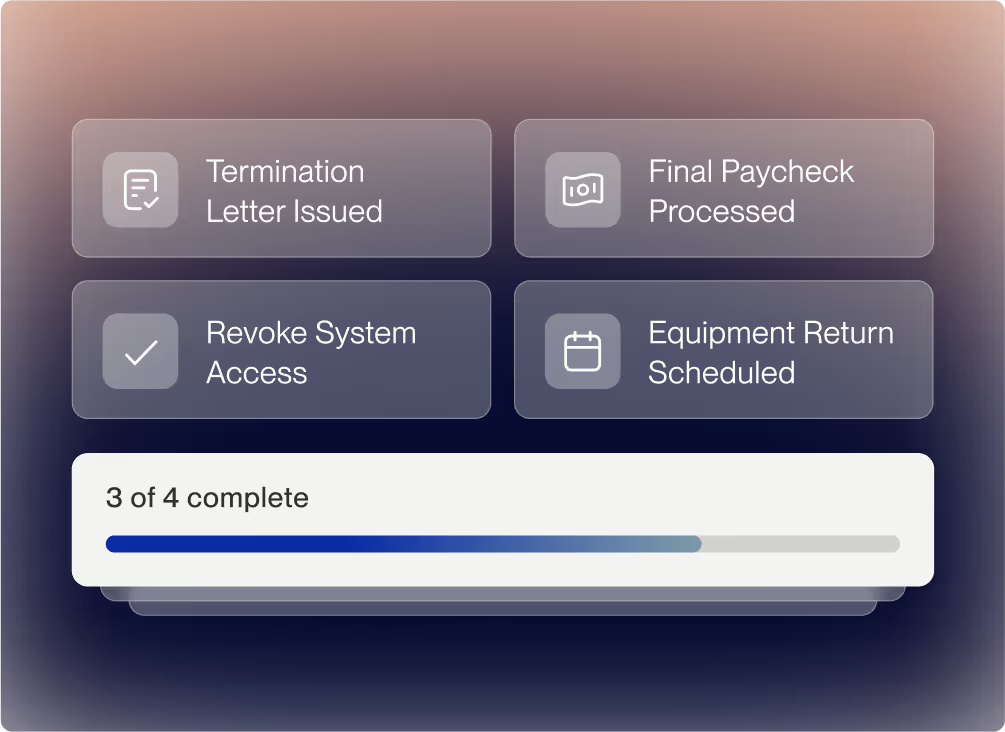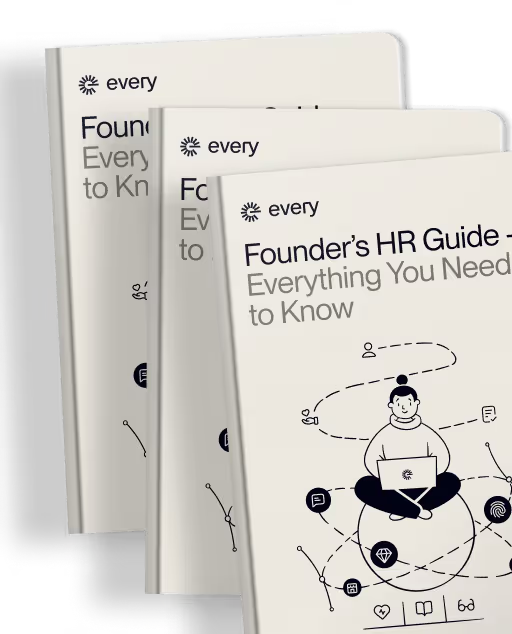Offboarding Checklist

While it’s always hard to say goodbye, it’s inevitable, so make sure you have an ironclad process in place to avoid any mishaps along the way. And whatever the reason for parting ways with your employee, a smooth transition is critical to minimize disruption to your business.
Here's an employee offboarding checklist:
1. Document resignations, layoffs, or terminations
Resignation: Ensure you receive a formal resignation in writing from your employee via email. Usually, a two-week notice is fair, allowing you to transition the team.
Layoff: In the unfortunate event your startup has to conduct layoffs, communicate in a 1:1 meeting with your employee and provide severance pay if you can. Be aware that these meetings can be tense and emotional, so do your best to remain compassionate to help ease tensions. Follow up in writing with a separation agreement sent to their personal email.
Underperformance: In the event of a termination due to underperformance, document performance issues over time. Ideally, provide them with feedback through a Performance Improvement Plan (PIP) that outlines areas for improvement and specific goals to achieve within a specified timeframe. If the performance issues remain unresolved, document them and proceed to termination.
Termination: Communicate the termination decision with your employee in a 1:1 meeting in a non-discriminatory and professional manner. Follow up with a written termination document and separation agreement sent to their personal email. Usually, terminations are effective immediately.
- Termination procedures must be handled with care to avoid wrongful termination claims or lawsuits.
- Always document performance issues.
- All states, except Montana, allow “at-will” employment. This means that either the employer or the employee can end the employment at any time, for any reason. Except for the following reasons, which are protected by law from termination:
- Discrimination based on race, sex, age (40 and over), nation of origin, disability, or genetic information.
- Retaliation for reporting illegal or unsafe workplace practices
- Refusing to conduct illegal activities.
Video - Advice from Rajeev Behera, Founder & CEO of Every and former Co-Founder & CEO of Reflektive on how to fire someone without burning bridges
2. Signed Separation Agreement (layoffs & terminations)
For layoffs and terminations, you’ll want to create a Separation Agreement and ask the departing employee to sign it as a way to terminate your employment contract with them. Separation Agreements can help protect your startup from future lawsuits.
What can be included in a Separation Agreement:
- Severance pay in exchange for the employee waiving the right to any legal claims against the company, such as discrimination, compensation, or any employment law claims.
- Continuation of benefits like COBRA
- Confidentiality clauses
- Non-compete clauses (if your state permits them, check your local regulations).
- Requiring employees to return company property, like laptops
- Get legal help on drafting any separation agreements and check federal and state regulations on what you’re allowed to include.
3. Deactivate IT systems and return company property
Coordinate with IT to deactivate the employee’s access to all company email, messaging, and software systems on the proposed date of termination. Usually, right after you communicate a layoff or termination, it’s best to lock them out of their company laptop and accounts immediately to avoid any issues.
Make sure you change passwords on any shared platforms. Startups often forget to remove ex-employees from their social media accounts. If you just fired someone, you’ll want to be careful.
Ensure the return of all company property, like computers, phones, or access cards.
4. Process final pay and benefits
Coordinate with Payroll to ensure final pay, including vacation and benefits, is distributed promptly according to the employee’s last day of employment.
5. Create an effective handover process
Facilitate a smooth transition by identifying who will take over the departing employee’s responsibilities in the interim.
Create a handover document outlining all the employee’s ongoing projects and identify who will be responsible in the interim.
Ensure any knowledge related to the departing employee is effectively documented and accessible, so other employees have access.
6. Conduct exit interviews
For employee resignations, conduct an exit interview to learn about the employee’s experience at your company and how you can improve as a company culture and as a leader.
7. Communicate the employee’s departure to your team
Communicate the employee’s departure to your team, either during a team meeting or through an email or Slack message, so everyone is informed about the change.
Let them know who will be the responsible person for key projects in the interim as well.
8. Communicate any layoffs or terminations to your state
By law, you’ll also need to communicate any terminations or layoffs to your state to enable employees to access their unemployment benefits.
9. Organize farewell happy hour or lunch (resignation only)
For resignations, consider organizing a company happy hour or lunch to celebrate their accomplishments and wish them well.
Every alumni employee could be a future customer, advocate, referral, or returning employee. So end on a positive note.
Lean on Every’s all-in-one platform for HR onboarding, payroll, taxes, & benefits
Are you feeling a little overwhelmed reading all of this? There’s a lot to do when it comes to bringing on a new hire. We get it. Lean on Every’s modern HR Payroll, Benefits, and Compliance platform to onboard your employees.
Unlike other SMB platforms, Every is built with startups in mind. It’s easy to set up and scales quickly too. Every eliminates the administrative headaches related to onboarding, payroll, and taxes, so you can focus on your vision and avoid any surprise penalties.
Here’s how we do all the heavy lifting for you when it comes to HR:
- Automated onboarding compliance. With Every, you can put payroll taxes, offer letters contingent on background checks, W-9 collection, and 1099 filing on autopilot.
- State tax account setup. We handle state tax registrations and filings, saving founders hours of work and helping you avoid penalties and paperwork.
- International hiring. Every can also help you bring on team members in over 200 countries through our EOR solution or work with international contractors using country-specific contracts – all managed in one place. No legal research, no compliance surprises, just building your best team regardless of borders.
- Affordable benefits: Our tech-specific health benefits packages are built for the modern startup. We’ve navigated these waters ourselves and created options that match what the giants offer without their massive budgets. A dedicated specialist will help you find the sweet spot between competitive benefits and financial sustainability.
Concierge white-glove support. Each client also gets their own Slack connect channel with our in-house specialists. These aren’t outsourced support agents–they’re actual payroll, benefits, and compliance experts who know your specific situation.
{{ebook-quote-6}}
If you found this helpful, you’ll get even more from the full Founder’s HR Guide.
{{ebook-cta}}












